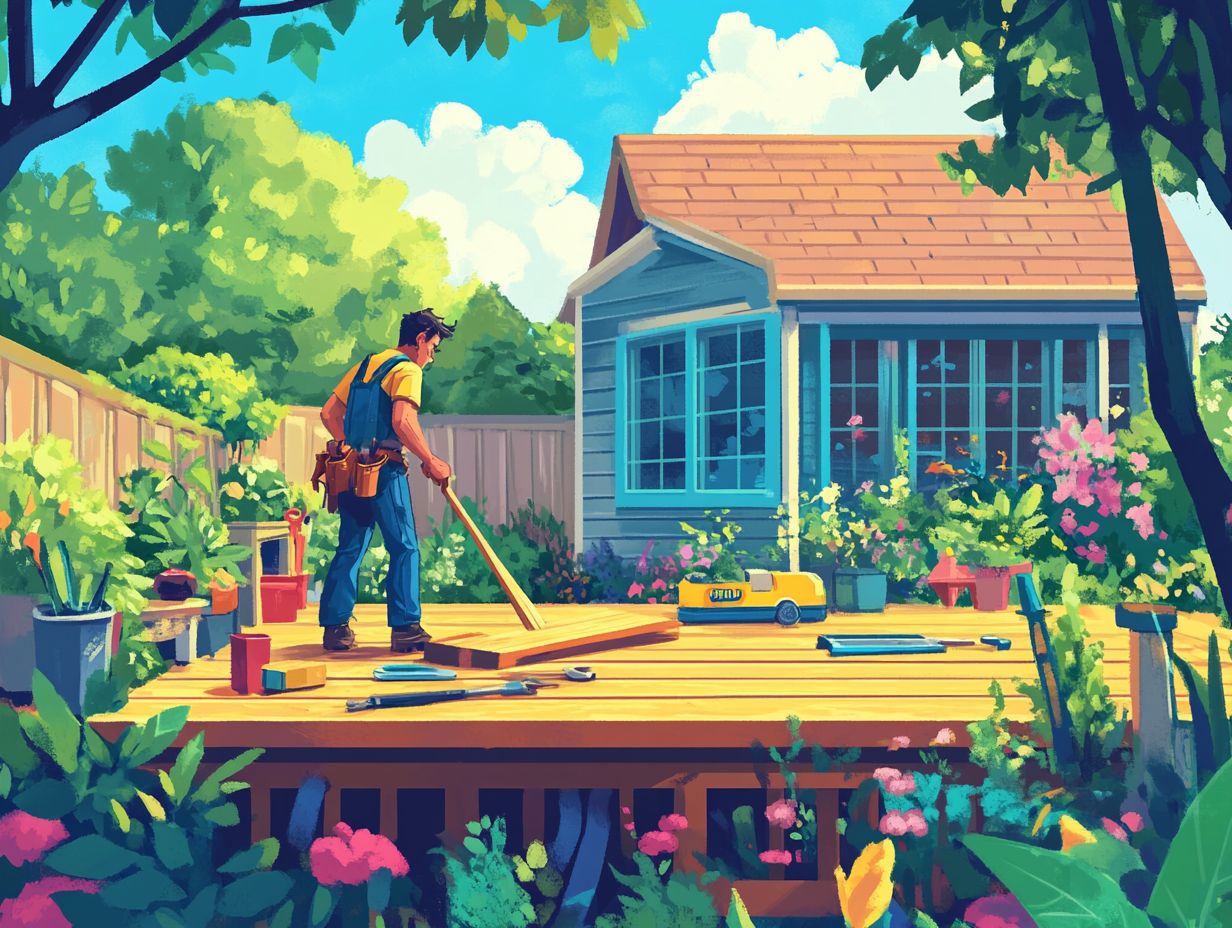Homeownership often inspires a desire to enhance comfort and style while increasing property value. DIY projects are an excellent way to achieve these goals, as they allow for customization of your space at a low cost.
This article highlights a variety of DIY projects, ranging from simple upgrades to advanced renovations, that can significantly increase your home’s market worth.
Additionally, it offers helpful tips for successful execution and identifies common mistakes to avoid. Get ready to channel your inner handyman and elevate your home!
Benefits of DIY Projects for Homeowners

DIY projects offer numerous benefits to homeowners, including enhanced property value and a greater sense of pride in their craftsmanship. Engaging in renovations and home improvement tasks allows property owners to save on labor costs while also customizing their living spaces. Incorporating smart home technology and energy-efficient features can lead to long-term savings on utility and maintenance expenses, making the property more appealing to future buyers.
The advantages of DIY projects go beyond practical considerations like increased property value; they positively impact both the financial and personal aspects of a homeowner’s life. Taking on these tasks fosters creative self-expression, transforming homes into unique reflections of individual personalities. Each completed project serves as a cherished memory that enhances the overall home while also building valuable skills and confidence.
Many homeowners choose to undertake renovations that align with current market trends, thereby increasing their homes’ marketability and demand. This approach not only boosts resale value but also makes the DIY process rewarding on both personal and financial levels. The satisfaction of building something from the ground up and witnessing the tangible results of one’s efforts elevates the home improvement experience into a fulfilling lifestyle.
Simple DIY Projects to Increase Property Value
Simple DIY projects can enhance property value by offering a cost-effective way to improve both curb appeal and interior design. While these projects require minimal investment, they can yield substantial returns in property appraisals and attract buyer interest.
Tasks such as painting, flooring, and landscaping can easily be undertaken by homeowners on a limited budget. These improvements create appealing outdoor living spaces that attract potential buyers, making a home more marketable.
With a bit of creativity and hard work, simple DIY projects can lead to significant enhancements in property value and increased equity.
Easy and Affordable Upgrades

Here are some examples of easy and inexpensive DIY upgrades for the home that enhance both functionality and aesthetics while remaining budget-friendly. Minor upgrades, such as changing fixtures, repainting walls, and improving landscaping, can significantly impact a home’s appearance and energy efficiency. By choosing low-cost projects, homeowners can create visually appealing spaces that are also functional and efficient, which is essential in today’s economic climate.
Easy DIY upgrades can enhance the quality of life in a space and may also boost the home’s resale value in the future. For instance, replacing old light switches with trendy dimmers is a simple upgrade that allows homeowners to adjust the mood of any room. Additionally, painting interior and exterior walls in fashionable colors can revitalize previously dull areas, while feature walls add personality and excitement to bland spaces.
Small landscaping improvements, such as adding potted plants or creating a gravel path, can enhance curb appeal without incurring significant costs. Each of these upgrades not only elevates a home’s aesthetic but also offers benefits like improved energy efficiency and reduced maintenance in the months and years ahead.
Intermediate DIY Projects to Add Value
Intermediate DIY projects can significantly enhance the value of your home, particularly in the kitchen and bathroom. These renovations not only allow you to infuse your personal style but also align your home with current market trends, making it more attractive to potential buyers.
Upgrades in the kitchen, renovations in the bathroom, and finishing the basement can transform functional spaces into stylish areas that increase the property’s overall value. It is essential to approach intermediate projects strategically to ensure the highest return on investment (ROI).
Projects for the Handy Homeowner

A wide variety of DIY projects are available for homeowners looking to enhance their living spaces with smart home technology. These projects can improve a home’s functionality while providing a satisfying sense of accomplishment.
Skilled homeowners can use these initiatives to incorporate high-quality craftsmanship that boosts property value, whether they are remodeling a kitchen, installing energy-efficient windows, or creating custom storage solutions.
DIY methods also help homeowners keep renovation budgets in check by allowing them to add features that may not be practical otherwise, such as a home office or gym. Engaging in projects like modernizing lighting systems with smart bulbs or implementing programmable thermostats can further enhance the home.
Homeowners will need to familiarize themselves with basic electrical work and may need to troubleshoot tech issues along the way.
Overcoming these challenges adds to the excitement and learning experience, ultimately leading to significant long-term savings on energy bills. The integration of such technologies not only adds convenience but also increases a home’s appeal to potential buyers.
By embracing these modern updates, resourceful homeowners can take pride in their ability to elevate their living environment while showcasing their skills and creativity.
Advanced DIY Projects for Maximum Value
Advanced DIY projects enable homeowners to maximize the value of their properties while showcasing their skills and creativity. These projects often involve complex renovations and the integration of home automation systems, which enhance the functionality of living spaces and significantly increase property equity.
Careful planning and the use of eco-friendly materials and equipment are essential to ensure that these advanced projects deliver both aesthetic appeal and economic benefits. Ultimately, advanced DIY projects demonstrate a commitment to quality and innovation.
Challenging but Rewarding Upgrades

Challenging yet rewarding upgrades can significantly enhance a homeowner’s property value and personal satisfaction. The sense of accomplishment that comes from completing complex DIY construction projects can be just as fulfilling as the upgrades themselves. These projects often require a high level of craftsmanship and an understanding of materials, making them ideal for homeowners who wish to elevate their skills.
Among the most challenging and rewarding upgrades are those that alter a home’s structural elements, such as remodeling a kitchen, adding a bathroom, designing an outdoor living area, or building a deck. Not only do these projects improve a home’s aesthetics, but they also contribute significantly to home equity. Research shows that they resonate well with buyers and are among the best home improvements for resale value.
Here is a list of challenging projects that can add value to a home:
- Bamboo, Tile, or Hardwood Flooring: Installing hardwood flooring is a complex yet rewarding DIY home improvement project. The entire process requires careful planning and execution, from selecting the right type of wood to ensuring the space is adequately prepared. If a subfloor is needed, it must be installed correctly, which involves choosing the ideal material and ensuring an even surface. A cork or felt underlayment is necessary to reduce noise, and the installation of each plank requires precise measurement and attention to detail. A table saw is essential for making exact cuts, and the wood should be allowed to acclimatize to avoid gaps during expansion. While a hammer and clamps can be used for installation, many homeowners find a nail gun easier to handle. Finally, the boards should be sanded and coated with a protective finish. This renovation not only beautifies your home but also boosts property value.
- Installing Porcelain or Other Types of Tile: After selecting the right tiles, the most challenging part is preparing the surface for tiling. This involves ensuring that the substrate (the surface to which the tiles will adhere) is level and clean. Careful planning and measurement are crucial, especially when cutting tiles that extend beyond the room’s width to ensure an even finish on both sides. It’s advisable to have extra tiles on hand, as they can easily be damaged during installation.
- Laminate or Engineered Wood Flooring: Laminate flooring consists of synthetic materials compressed together, while engineered wood flooring features a layer of wood over synthetic materials. Both options offer the appearance of hardwood at a lower cost and are relatively easy to install, provided the ground is even and the right tools are available. For larger areas, homeowners may need to rent a laser level to ensure proper alignment. Laminate installation requires a foam underlayment, and the area must be measured accurately, removing any furniture first. Circular saws, jigsaws, or laminate cutters will be necessary for cutting, with a jigsaw being the best choice for strips that fit against walls or corners. These flooring options are cost-effective and can increase your home’s aesthetic appeal.
- Carpet Installation: Various carpet styles, including shag, Berber, and looped, are available, and the installation process is time-consuming, requiring precision and planning. It’s advisable to have a team to help move furniture, roll out the carpet, and perform cutting tasks. The project may take two or more days. Start by removing the old carpet carefully, rolling it up, and pulling out nails and staples. If the padding is damaged, it should be replaced, and any uneven flooring may require leveling with a cement underlayment. Once the area is prepared, the new carpet can be rolled out, cut, and secured using tacks or adhesive. Tools like a power stretcher and knee kicker aid in ensuring a tight fit.
- Interior Trim (Baseboards, Crown Molding, and Chair Rails): Interior trim pieces, available in various materials, styles, and colors, are sold in long, straight segments, making installation challenging without the right tools. A miter saw is crucial for making precise cuts, while a finishing nail gun is needed to secure the trim in place. For wider areas, multiple pieces may need to be fastened together, requiring the use of a square to ensure even joints. In humid climates, homeowners should opt for solid or engineered wood instead of composite materials, which may warp.
- Custom Built-in Shelves: Building custom shelves is an excellent project for beginners looking to enhance their skills. While not as complex as other home projects, it still requires knowledge of carpentry, engineering, and design. Various styles are available, but essential tools include a stud finder, laser level, drill, miter saw, and finish nail gun. First, create a plan that outlines the desired features, such as length, depth, number of shelves, and possible lighting. Shelves should be spaced 12-16 inches apart for multiple items or 24-36 inches apart for larger items. Once the design is finalized, cut the lumber to the specified lengths, ensuring precision with a miter saw. Sanding edges and painting or staining should be done outdoors to avoid fumes. This project enhances your interior design and provides practical storage solutions.
- Wood Siding and Outdoor Living Spaces (Patios, Decks, Garages, Fencing, Landscaping): Outdoor projects can enhance beauty and functionality while connecting homeowners with nature. However, they require an understanding of seasonal changes, including temperature, precipitation, wind, and sun exposure. It is essential to avoid imbalances that detract from the overall appeal. Consulting with a designer or architect can provide valuable insights. Outdoor structures should have a strong foundation and utilize durable materials designed to withstand environmental elements. These outdoor living spaces are perfect for entertaining and can significantly increase your property’s curb appeal.
- Patio Construction: To build a patio, measure the area and mark the corners. Dig a trench approximately 6 inches deep, followed by adding gravel and sand. Finally, place flat stones or concrete slabs on the surface and fill the gaps with sand.
- Deck Building: Constructing a deck requires careful planning for optimal design. Start with footers made from treated wood and concrete blocks, ensuring proper drainage with gravel. For larger decks, poured concrete footers may be necessary, and the structure should be leveled using a string line before securing the boards.
- Garage Construction: A garage can be built using wood, brick, or metal materials. Ensure its alignment with the home’s front and maintain a level foundation. Use shingles and siding that match the house for a cohesive appearance.
- Fencing Installation: Place fence posts at each yard corner and additional posts every four to six feet. Each post should be set three feet into the ground and filled with concrete. Select materials that complement the home.
- Landscaping: Begin landscaping by incorporating existing trees, bushes, and features, while selecting plants that harmonize with the indoor aesthetic. Proper spacing and watering, along with adequate sunlight, are essential for healthy growth. Consulting local nurseries can help homeowners choose suitable plants for their region.
Outdoor renovations demand time and a thorough understanding of the environment, making it wise to start with small changes and seek professional advice. Landscaping can dramatically improve curb appeal and encourage outdoor living, while also being a budget-friendly way to enhance your property.
Tips for Successfully Completing DIY Projects
DIY projects necessitate careful planning and execution to ensure that homeowners have the appropriate tools and materials. Effective budget management and a solid understanding of material selection for DIY projects, combined with thoughtful planning strategies for renovations, enable homeowners to navigate the challenges of home improvement tasks successfully. Investing time in research and learning about home improvement techniques can lead to projects that boost property value and enhance curb appeal.
Utilizing the right planning tools helps homeowners stay organized throughout the renovation process, allowing them to complete tasks on time and within budget. Ultimately, the success of home improvement projects hinges on thorough preparation and creativity, enabling homeowners to bring their visions to life with beautiful upgrades. This is especially important for more complex projects like kitchen upgrades or energy efficiency improvements involving modern appliances and smart home technology.
Tools, Materials, and Safety Precautions for Home Improvement
A successful DIY project is defined by the use of the right tools, appropriate materials, and the inclusion of safety measures, all of which contribute to an efficient workflow.
The importance of quality tools and materials is evident in how using high-quality hand tools and power tools enhances the accuracy of the project while minimizing the risk of tool failure. Choosing the right type of material, whether it is lumber for a new deck or paint for a room’s restoration, can significantly impact both durability and appearance. Additionally, using eco-friendly materials can add to the sustainability of your home.
Additionally, incorporating safety gear such as goggles and gloves is essential, as it protects against potential hazards that may arise during a project. By fostering a safe environment and utilizing proper equipment and materials, homeowners can undertake home improvements that are both rewarding and secure. Regular maintenance tips and seasonal upgrades can further prolong the life of these improvements.
Common Mistakes to Avoid in DIY Home Improvement and Renovation
Mistakes in DIY home improvement projects are common but can be easily avoided. Taking precautions against these mistakes can help DIY homeowners save both time and money. For example, always obtain the necessary building permits and be aware of zoning regulations before starting any major renovation.
Some of the most frequent errors in home renovations are related to project planning, execution, and material selection. By learning from the experiences of other DIY enthusiasts, homeowners can better prepare themselves to tackle their own improvement projects, increasing their chances of successfully meeting both functional and aesthetic requirements. Engaging in proper home inspection can also preemptively identify issues before they become major problems.
Recognizing the importance of thorough project preparation and attention to detail will contribute significantly to the overall success of the project. This includes planning for seasonal maintenance and regularly updating your home exterior to maintain curb appeal.
Lessons Learned and How to Avoid Them
Homeowners can apply lessons learned from past DIY projects to enhance the planning and execution of future endeavors. By reflecting on what went wrong—such as taking too long to complete tasks or neglecting to use safety equipment—homeowners can develop improved strategies for similar renovations in the future. This could also involve integrating smart home devices or planning for home office setup to adapt to changing needs.
Utilizing available resources and guides can provide valuable assistance, helping to avoid previously encountered pitfalls. This reflective process is a normal part of any DIY journey and is essential for the successful completion of home improvement projects. Additionally, consulting local contractors and keeping up with design trends can offer new ideas and strategies for future projects.
Moreover, it fosters the development of project management skills, enabling homeowners to approach each new task with greater clarity and understanding. For instance, creating a strict timeline and a materials checklist can be instrumental in staying organized. Engaging with community resources or online forums can also offer individuals the extra support and insights relevant to their specific DIY projects.
Emphasizing the importance of research and planning not only enhances the quality of the work produced but also instills confidence in the abilities of everyday individuals tackling DIY projects, renovation, and home improvement tasks. The lessons learned serve as building blocks toward eventual mastery, transforming any house into a home. Additionally, understanding property value and how home improvement projects, such as landscaping, painting, kitchen upgrades, and bathroom remodels, can contribute to curb appeal and overall property value is essential.


